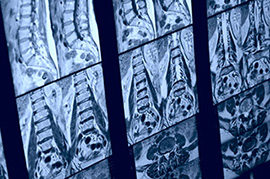Causation Issues in Cases Involving a Delay in Diagnosis
Causation can be a very difficult, and sometimes insurmountable, hurdle in bringing a successful claim alleging a delay in diagnosing a condition.

Spinal cord injuries are devastating for the patient and for their loved ones. Depending on the spinal cord level and its severity, it may impact all areas of life. You may be more familiar with spinal cord injuries for those suffered from the trauma of a car crash or a sports injury, but medical negligence cases for spinal cord injuries often are based on delays and failures to diagnose spinal cord compression.
Three common claims for delays and failures to diagnose spinal cord compression are from a spinal epidural abscess, a compression caused by a spinal epidural hematoma, or cauda equina syndrome. These conditions involve masses impinging on the spinal cord, and, if left untreated, causing death of spinal cord tissue. Death of spinal cord tissue can cause permanent motor and sensory deficits, including paralysis.
A spinal epidural abscess (SEA) is a collection of pus between the covering of the spinal cord (dura) and the vertebral bone through which the spinal cord runs. If the infection grows big enough, it will start compressing the cord, and this in turn causes neurological deficits. These might include numbness in feet or legs, or dysfunction of the bladder or bowel.
One of the most important diagnostic clues for a diagnosis of spinal epidural abscess is fever. Next is the onset of new neurological symptoms like difficulty walking or leg weakness. Malpractice may occur where a provider fails to recognize the significance of new onset neurological findings, or minimizes a patient’s complaints. Time is of the essence in treating an SEA, and even the delay in getting an MRI scheduled may be enough to cause permanent loss of function. Treatment often involves draining the abscess to relieve the compression and prescribing antibiotics.
Spinal Epidural Hematomas (SEH) are caused by post-operative bleeding following spine surgery. This most often happens if the surgeon punctures the dura. Post operative bleeding in the narrow spaces of the spinal cord means a bleed can quickly compress the cord. The hallmark symptoms of SEH are decreased strength, decreased sensation, and urinary retention. It is up to the surgical team to do post-operative neurological assessments and to note any abnormalities. If an SEH occurs, timing is of the essence, so it is critical to immediately drain the hematoma to restore function to the spinal cord.
Cauda equina syndrome (CES) develops when the patient’s spinal cord is compressed in the lumbar spine. The mechanism of cord compression in cauda equina is often the result of a herniated disc that is compressing the nerve bundle at the base of the spinal cord, called the “cauda equina.” Like all cord compression cases, early intervention is the key to preventing permanent injury. The most common early symptom of cauda equina – back pain – is one of the most common emergency department complaints. If the patient has back pain and urinary retention, urinary incontinence, fecal retention, fecal incontinence, loss of anal sphincter tone, sexual dysfunction, or saddle anesthesia (sensory dysfunction in the areas that would contact a saddle), cauda equina should be on the doctors’ differential diagnosis. A provider must get a thorough history and perform a thorough physical exam in order to rule out CES. A negligence claim may arise out of a provider’s inadequate diagnostic exam, or if she or he fails to order imaging when the patient has sufficient clinical indications. Once the herniation is identified, emergency surgery is necessary to relieve the pressure of the herniated disc and restore function. If the delay is long enough, however, function may never be restored.
It is well understood that sooner is better in diagnosing and treating any spinal cord compression case. If you or a loved one has suffered permanent injury due to spinal cord compression, reach out to our offices to see if we can assist you with your claim.
Jim presented to his local ER complaining of middle and lower back pain. He was given pain medication and told to return if it didn’t get better. He came back two days later and ER personnel told him the same thing. He came back later that day and the ER doctor ordered imaging done of his low back, but those images did not explain the symptoms he was experiencing. Still, he was discharged.
He returned by ambulance the next day because he could not walk up the steps from his home to get into a personal car. He was admitted for observation and pain control. Over the next three days the strength and sensation in his legs worsened, and he continued to have bowel and bladder control problems.
Finally, his doctor realized Jim couldn’t move his legs and sent him via ambulance to a nearby hospital with a neurosurgical department. Imaging of the entire spine found a large epidural abscess in the mid-back area compressing on his spinal cord. A neurosurgeon performed emergency decompression, but unfortunately Jim was left with permanent motor and sensory loss in his legs and loss of bowel and bladder control.
CMG was able to obtain a multimillion dollar settlement to provide for Jim’s care.
Causation can be a very difficult, and sometimes insurmountable, hurdle in bringing a successful claim alleging a delay in diagnosing a condition.
Medical errors are the third leading cause of death in the United States, but often times the victims of these errors never learn the full story.
In an increasingly complicating medical world, checklists can help surgeons and other doctors avoid missing key steps and making mistakes that can cause patients harm.

